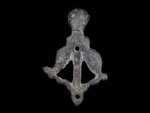 |
Artifact No.1 |
© David Xavier Kenney 2005 |
|
| |
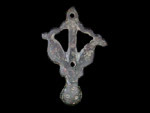 |
Artifact No.1 |
© David Xavier Kenney 2005 |
|
| |
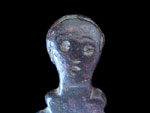 |
Artifact No.1 |
© David Xavier Kenney 2005 |
|
| |
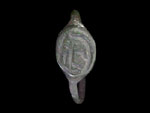 |
Artifact No.2 |
© David Xavier Kenney 2005 |
|
| |
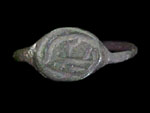 |
Artifact No.2 |
© David Xavier Kenney 2005 |
|
| |
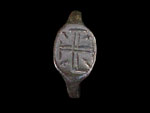 |
Artifact No.3 |
© David Xavier Kenney 2005 |
|
| |
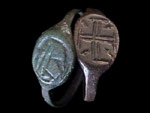 |
Artifacts No.2 & 3 |
© David Xavier Kenney 2005 |
|
| |
|
Etruscan Or Roman Republician (or Celtic?) Crossbow Applique
Although it could be even older, I believe that this artifact (Artifact 1) is a 4th to 2nd c BC Bronze Etruscan or Roman Republic (or Celtic) Applique which may have been used as an insignia for a helmet. There are two holes for rivets with a stud on the back. The art is somewhat similar to a later type of stylized Celtic art and it may even be from that culture. If of the Celts then the symbolism should have at least some association with the god Ogmios (a Celtic version of the Greek Hercules) who was a god of speech (note the open mouth on the face of this applique) and the inventor of the Druidic alphabet, his weapons were the bow and, or, a club. One of the dings on the applique reveals that it may have been gold gilded. The head is worn but shows a bearded face with an open mouth. Each of the eyes is made with a line through the center. This gives the illusion that the eyes follow the object’s beholder when the face is tilted up or down. It also shows a round hat or cap worn on the back of the head. The shape of the applique from the head down suggests an anchor, waves, a snake, and possibly dolphins. The dolphin shapes could also represent arms, or possibly legs. Less obvious is that the appliques form suggests a crossbow, and could show the way an ancient mechanical belly crossbow (the Gastraphetes) was strung. That is, with a half circle stock on the stomach; the bowman then gripped each handle of the composite bow while pressing down as to load the string by notches, bending the bow until it was fully cocked. It was then loaded with a bolt or a dart and fired by a trigger. Although there are no known depictions of this weapon in art, there is a very detailed description of the device written by the 1st c AD mathematician and engineer Heron (or Hero) of Alexandria. According to Heron the Gastraphetes was the first artillery piece and was invented by the Greeks circa 400 BC in Syracuse, in fact it may be much older. There were many later, larger and more sophisticated catapults invented but none were loaded the way the Gastraphetes was and most were crew served. This catapult as seen on the applique may have had a connection to a legendary Etruscan founding father known as Tarchon the ploughman. Although Tarchon is given a founding status, he is different from other founders of peoples in that Tarchon doesn't really seem to do much. It is rather what he finds that gives him his status. Tarchon was ploughing a field near Tarquini when an infant boy with snake legs (note the position of the snake on the applique) sprang from the furrow. Tarchon shouted (note the open mouth on the applique) which brought all of his people to see the boy. The boy was named Tages. He instructed the Etruscans in divination and perhaps other religious knowledge and then died. Later the Etruscans recorded the wisdom of Tages in 12 sacred books they called the disciplina etrusca. These books guided the Etruscans in their day to day lives and in their collective fate. Unlike the later Romans, the Etruscans believed in a form of predestination. The shape of this applique does seem to suggest a man and a plow but also an anchor and the Gastraphetes, although it will not be explored there is a remote possibility that this shape is also associated with a water dowser. The anchor is easy to explain as the Etruscans, along with being agriculturalists, were in fact a sea faring people (unlike the Romans) and were credited by the Romans as having invented the anchor along with the rostrum (a ship’s battering ram). To explain the Gastraphetes may be much more complex but even more interesting. If the applique is turned upside down it will show the same form as the kite shape of the constellation/star Arcturus (also called Bootes). With this in mind, in front of the top border of Bootes is the constellation Draco, which some ancient peoples referred to as a great snake. This all seems to imply that if the head of the applique is the star Arcturus and the rest is in the shape of the Arcturus constellation, then this shape can be seen as a cocked crossbow with a flaming dart. The fact that the snake is seen also implies that the constellation Draco in front of the constellation Arctrurus is harnessed into the bow of the crossbow. The crossbow symbolism may have been derived from an older bow symbolism which would have worked just as well with the primary shape of the constellation of Arcturus. If the symbolism is combined with an annual heavenly event such as meteor showers, then this would seem even more likely. Such an event which originates from Bootes does occur three times a year. The biggest event is the Quadrantids, which begins on Dec. 28th and peaks on the night of January 3rd and 4th. It lasts until January 7th. During the peak night 50 to 120 meteors per hour can be seen, but this lasts only a few hours. Other meteor showers associated with Bootes are the January Bootids (9 January through 18 January) and the June Bootids (27 June through 5 July). It should be noted that at least some aspects of ancient astronomy should coincide with what we see in the night sky today; however we can only presume and guess what the ancients saw. Nevertheless if this meteor shower had been regularly observed (or had even existed at that time), then it is probable that on occasion a meteorite fireball could have been witnessed. This may have appeared to the ancients as a fire bolt coming from the crossbow of Arcturus, and the bright red/yellow star Arcturus would appear to have been where this heavenly event originated.
If this theory is correct then Tarchon, besides being a ploughman, may have also been associated with being a metalsmith, since this applique seems to associate him with metal tools and a weapon. The legend of Tages may have arisen from a meteor event or inspired by a unique shaped meteorite that had been found by an Etruscan farmer (or an earlier people) while ploughing the fields.
Besides the obvious symbolism of the anchor and dolphins, the crossbow may also be associated with the nautical. By the 3rd c BC the Greeks (and it can be presumed the Etruscans) had various crossbow-type catapults (Oxybeles) fore on their war ships. It can be expected that these were used to launch darts, bolts and flaming darts at enemy warships. In the Battle on the Shore part of Virgil’s Aeneid, an Etruscan King (not the founding ploughman of the same name) named Tarchon, who had allied himself with Aeneas, provided eight thousand men in thirty ships for an upcoming battle with the enemies of the Trojans, the Latin tribes. Aeneas is with Tarchon when it is noted that the Tuscans (Etruscans) believed that Aeneas was chosen by their gods to be their new king. They rowed down a river escorted by water nymphs (although later it is mentioned that they are on the sea). One of the nymphs told Aeneas to put on his armor which the fire god made for him. Upon Aeneas’s arrival with the Tuscans for an amphibious landing, he was at the stern on his ship. He lifted his shield for his waiting men (Trojans) and for his enemies (Latins) to see. It is noted that his helmet and shield shone like a terrible light, much like a comet at midnight. The fact that this is mentioned in conjunction with Tarchon may be significant in supporting the theory that Tarchon is associated with celestial fire and meteors.
If Tarchon was among other things a celestial metalsmith shooting fire dragon (snake) darts through the heavens, and had invented the plough and the anchor, he may have been associated with heavenly gifts or heavenly vengeance and perhaps the steering of events or destiny. Some of the design in this applique also suggests male and female fertility symbolism, and Tarchon’s plowing may also have been a metaphor for fertility. This would be very much in line with the more ancient Indo European mythology concerning the advent of the plough.
The constellation Arcturus is a Greek name for the bear guard, but it is also known as the bear watcher, bear herder, or bear chaser. The name Bootes is of uncertain origin, but to the ancient Greeks it meant the ploughman or the herdsman. There are some who claim that this name may mean “The Shouter” as in a herdsman shouting to or at his charge. If so, then the Etruscan Tarchon and the figure on this applique both appear very much to be Shouters. Certain Greek myths have Arcturus as a star, others as a constellation with the star included. To the best of my knowledge, these are always connected with bear symbolism. The Greek myths in which Bootes is a ploughman or a herder appear to be much more ancient and of an Anatolian or Middle Eastern origin. In these myths the character as Bootes teaches his people about agriculture and farming. With Bootes as Arcturus (the Bear Watcher) it appears that the Greek myths associated with this may be of Thracian or Scythian origin. The ancient people of the Euphrates and the ancient Arabs saw the constellation of Arcturus as a Shepherd. To the Romans (and now perhaps to the Etruscans) this constellation was associated with the ploughman.
The Etruscans had a rite of the plough which the Romans called Ritus Etruscus. This was the religious rite of ploughing a new city’s boundaries with a plough hitched to a white cow and a white bull. The plow’s blade had to be made of metal. With the founding of Rome, when Romulus performed this ritual his brother Remus challenged him by crossing the ploughed line. Romulus killed him with his sword. The rite of the Ritus Etruscus was written in the disciplina etrusca.
The Roman word for plough is Arator (Aratoris) and it very well may be from an Etruscan word with a similar meaning; the Etruscan name Tarchon may be a clue. There are some who have theorized that the family name of the 2nd c AD Roman General Lucius Artorius (Artori) may mean ploughman, originating from the Roman arator. The Roman dux (Special General) from Britain Lucius Artorius Castus is considered by many to have been an inspiration to the Medieval writers for the image of a King Arthur.
Included with this artifact are two bronze rings circa 12th to 14th c AD. Both rings are similar in style, were purchased from the same source, and are exactly the same size. They may be of Norman, French, German (Berne?), or Kievan Rus origin. The first ring Artifact 2 shows on its bezel the bust of a medieval warrior (Crusader?) with a helmet with two streamers and a nose guard in profile. He is also wearing a bow under his chin, the bow may or may not be associated as symbol for a cloak, in turn the cloak may have been an ancient symbol for soldiers as guardsmen. When this ring is turned to one side it shows the upper part of a bear rampant with two fangs. The second ring Artifact 3 shows on its bezel an unusual Crusader-type cross made from crossbow bolts. Crossbowmen were regularly used by all of the Crusader armies but this type of cross style is usually associated with the Crusader Orders, particularly with the Knights Templar. It should be noted that the crossbow is thought to have been in use in Europe from the 9th c AD onward, but it was only introduced to England in the 11th c AD by the invading Normans. In 1097 and 1139 crossbows were outlawed by the Roman Catholic church as weapons that could not be used against Christians. Just as the Medieval Arthurian legends appear at the advent of the Crusades, the popularity of the crossbow as a weapon of war may have had just as much to do with a tradition of an ancient celestial myth as well as with a practical use.
Copyright 2005 David Xavier Kenney
Posted on 29-NOV-05
|

